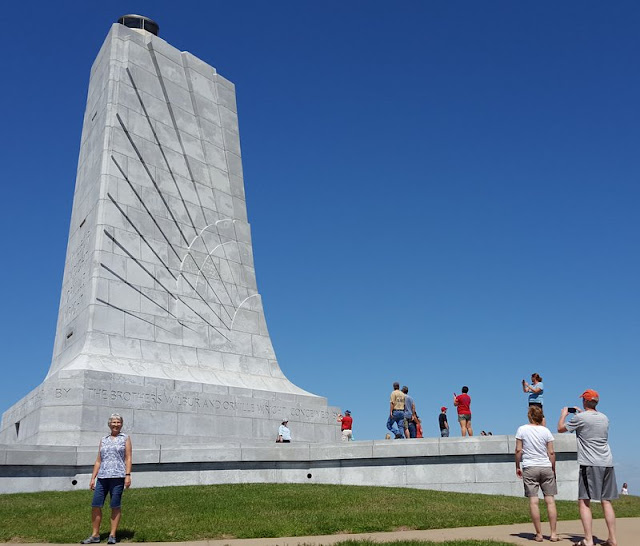Our first stop was to Kitty Hawk to see the place where aviation was born. Connie and Denisa are standing in front of a boulder that memorializes the place where the first successful flight of an airplane started.

But we must back up a little to tell the whole story of the things that happened here. The Wright brothers had been experimenting in their bicycle shop in Ohio with building a frame that would support flight. But they needed a place to test their ideas. The ideal place needed three components--sand (for softer landings), wind (to give their wings lift), and isolation (to keep their project secret). They found all three of those in Kill Devil Hills, North Carolina. (We also mused that they could have also found those three items in Beaver, Oklahoma--home of the windy Beaver Sand Hills park. Denisa is standing on Kill Devil Hill. This grassy hill was once a sand dune.
It was from that vantage point that the Wright Brothers would jump off with their glider--the precursor of the first airplane. A full scale model of that glider was on display at the national park visitor center.
It was on this hill that the memorial to flight was constructed.
The memorial includes busts of the Wright brothers. Mark is loaning shoulders and ears to Orville Wright this morning.
There were descriptive words engraved into the monument, and Steven just happened to pause next to the word that he felt most described himself.
After making changes to the wings and adding a rudder, the brothers were finding increasing success in controlling their gliding exercises. So they were ready for the next step of motorized flight. This full scale model of the first motorized airplane is housed in the visitor center.
It is demonstrated by the most enthusiastic park ranger we have ever encountered. We have sat through many national park films, but this location uses a live ranger performance to get the audience involved and actually see the levers and gears in motion on the exact replica.
It was on December 17, 1903, that the perfect weather gave the best chance of successful flight. So the brothers carried their prototype airplane out of the garage beside their cabin that is still standing.
They started their flight next to the large boulder that is pictured at the beginning of the blog. No longer on the hill that they used for gliding, this airplane would have to attain lift from its motor-driven propellers from its start in the flat meadow. This grassy meadow was once filled with sand on that cold day in December 1903. Mark is standing close to the airplane's starting point, and Denisa, Connie, and Steven are standing at the granite monuments that indicate the ending points of the first, second, and third flights of the day.
Those first three flights were 120 feet, 175 feet, and 200 feet respectively. But what made real history that day was the flight to the fourth granite marker that we can't see below because it is all the way to the trees in the picture below.
The fourth flight was in the air for 59 seconds, and went 852 feet. It was the first successful manned flight!
Instead of "Wandering His Wonders," this day we were wandering history. It was awesome to get to walk where aerial history was made. North Carolina proudly flaunts this achievement on its car tags that proclaim it is "First in Flight." (We think that it is interesting that Ohio--where the Wright brothers were raised and had their bicycle shop--proclaims it is the birthplace of flight.) All that walking can sure work up an appetite, so we headed further north up the OBX to the little town of Duck. Home to the growing franchise of Duck Donuts, this place had been recommended by residents of the state. So we stopped in for a treat.
They start with white cake donuts that are fried right there in their store. But what makes them unique is the way customers order them. We could choose from many different glazes, then a handful of toppings, and finally a multitude of drizzles.
They are cheaper by the half dozen, so we felt that was reason enough to buy six. Starting at the upper left and going clockwise, we have maple glaze with real bacon sprinkles; strawberry glaze with coconut and raspberry drizzle; peanut butter glaze with nuts and chocolate drizzle; chocolate glaze with nuts and caramel drizzle; lemon glaze with chocolate sprinkles and raspberry drizzle. We completed the circle with another maple and bacon donut because it sounded so intriguing and had been recommended.
We cut each donut into quarters so that the four of us could try each one. We now highly recommend Duck Donuts for a decadent snack. The empty box is evidence that we ate every morsel.
Empowered with all those calories, we headed up the road to the furthest north town on the OBX, home of the Currituck Beach Light Station.
Built in 1875, this lighthouse is unusual with its red brick exterior. We found that over a million bricks were used to make this 162 foot beacon. Most of the lighthouses we have seen are made of brick, with a white plaster applied to the outside. Still functional, the light shines from dusk to dawn, warning ships in the Atlantic of their proximity to the shore.
The OBX is a long thin barrier island that is 130 miles long. At some points the island is less than a mile wide. So the distance is short between the Atlantic Ocean (where the lighthouse above is protecting the coast line) and the bay (home of the historical bridge below).
There were some beautiful live oak trees surrounding the bay, and surprisingly (not!) Mark decided to try to climb one. He was struggling with that first tall step into the tree bough. Denisa just happened to click the picture as Steven gave his friend a boost. Mark wasn't expecting that boost, and was almost catapulted right through the tree.
After regaining his composure, we got a picture of Mark up in the tree--compliments of a little help from a friend.
There is only a single highway that runs the entire length of the OBX, so it would be hard to get lost on this narrow island. We crossed that highway and wandered onto the Atlantic sea shore.
As we were wandering the beach, we found something that we had never seen before. This is called a mermaid's purse, and it is actually the egg case of a skate (which is a relative of a sting ray). We feel like we have wandered upon another of God's wonders when we find little snippets of His unique plan for so many creatures in this world.
We didn't find many unbroken shells on the beach. But we did find an unusually large number of shell fragments that were predominately purple in color. We took our shell pieces, and formed our ode to our newly learned abbreviation of the Outer Banks.
Our day on the island was a long one, so we decided to split our wanderings into two blog posts. So this adventure is to be continued . . .























No comments:
Post a Comment